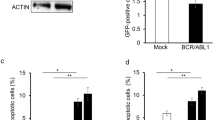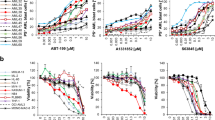Abstract
The BCR–ABL fusion transcript encodes the BCR–ABL tyrosine kinase (TK), which causes chronic myelogenous leukemia (CML). Although the TK inhibitor imatinib mesylate, which targets the BCR–ABL protein, has been proven to be effective in controlling leukemic growth, imatinib resistance has been observed with disease relapse because of point mutations in the ABL gene that inhibit imatinib efficacy. In this study, we designed oligodeoxyribozymes (DNAzymes) that specifically target and cleave both the junction sequence and the site of the point mutation (T315I), conferring imatinib resistance in BCR–ABL mRNA. DNAzymes significantly induced apoptosis and inhibited proliferation in wild-type and T315I-mutant BCR–ABL-positive cells. Selective cleavage of T315I-mutant ABL mRNA by DNAzyme (T315I Dz) led to cell cycle arrest in G0/G1 phase, with induction of caspase-3/-7 in imatinib-resistant BCR–ABL-positive cells harboring the T315I mutation. Moreover, cotreatment with the DNAzyme targeting the T315I mutation and imatinib resulted in enhanced inhibition of proliferation and induction of apoptosis in T315I leukemic cells as compared with imatinib alone, thereby antagonizing imatinib resistance in CML cells bearing T315I-mutant BCR–ABL. Therefore, cleavage of T315I-mutant ABL mRNA by DNAzyme combined with imatinib treatment may be an alternative approach to overcoming imatinib resistance in leukemic cells.
This is a preview of subscription content, access via your institution
Access options
Subscribe to this journal
Receive 12 print issues and online access
$259.00 per year
only $21.58 per issue
Buy this article
- Purchase on Springer Link
- Instant access to full article PDF
Prices may be subject to local taxes which are calculated during checkout






Similar content being viewed by others
References
Daley GQ, Van Etten RA, Baltimore D . Induction of chronic myelogenous leukemia in mice by the P210bcr/abl gene of the Philadelphia chromosome. Science 1990; 247: 824–830.
Faderl S, Talpaz M, Estrov Z, O'Brien S, Kurzrock R, Kantarjian HM . The biology of chronic myeloid leukemia. N Engl J Med 1999; 341: 164–172.
Rowley JD . Letter: A new consistent chromosomal abnormality in chronic myelogenous leukaemia identified by quinacrine fluorescence and Giemsa staining. Nature 1973; 243: 290–293.
Groffen J, Stephenson JR, Heisterkamp N, de Klein A, Bartram CR, Grosveld G . Philadelphia chromosomal breakpoints are clustered within a limited region, bcr, on chromosome 22. Cell 1984; 36: 93–99.
Shepherd P, Suffolk R, Halsey J, Allan N . Analysis of molecular breakpoint and m-RNA transcripts in a prospective randomized trial of interferon in chronic myeloid leukaemia: no correlation with clinical features, cytogenetic response, duration of chronic phase, or survival. Br J Haematol 1995; 89: 546–554.
Goldman JM, Melo JV . Chronic myeloid leukemia--advances in biology and new approaches to treatment. N Engl J Med 2003; 349: 1451–1464.
Cortez D, Reuther G, Pendergast AM . The Bcr-Abl tyrosine kinase activates mitogenic signaling pathways and stimulates G1-to-S phase transition in hematopoietic cells. Oncogene 1997; 15: 2333–2342.
Gesbert F, Sellers WR, Signoretti S, Loda M, Griffin JD . BCR/ABL regulates expression of the cyclin-dependent kinase inhibitor p27Kip1 through the phosphatidylinositol 3-Kinase/AKT pathway. J Biol Chem 2000; 275: 39223–39230.
Nimmanapalli R, Fuino L, Bali P, Gasparetto M, Glozak M, Tao J et al. Histone deacetylase inhibitor LAQ824 both lowers expression and promotes proteasomal degradation of Bcr-Abl and induces apoptosis of imatinib mesylate-sensitive or -refractory chronic myelogenous leukemia-blast crisis cells. Cancer Res 2003; 63: 5126–5135.
Dubrez L, Eymin B, Sordet O, Droin N, Turhan AG, Solary E . BCR-ABL delays apoptosis upstream of procaspase-3 activation. Blood 1998; 91: 2415–2422.
Steinberg M . Dasatinib: a tyrosine kinase inhibitor for the treatment of chronic myelogenous leukemia and philadelphia chromosome-positive acute lymphoblastic leukemia. Clin Ther 2007; 29: 2289–2308.
Druker BJ, Talpaz M, Resta DJ, Peng B, Buchdunger E, Ford JM et al. Efficacy and safety of a specific inhibitor of the BCR-ABL tyrosine kinase in chronic myeloid leukemia. N Engl J Med 2001; 344: 1031–1037.
Tsao AS, Kantarijian H, Talpaz M . STI-571 in chronic myelogenous leukaemia. Br J Haematol 2002; 119: 15–24.
Bradeen HA, Eide CA, O'Hare T, Johnson KJ, Willis SG, Lee FY et al. Comparison of imatinib mesylate, dasatinib (BMS-354825), and nilotinib (AMN107) in an N-ethyl-N-nitrosourea (ENU)-based mutagenesis screen: high efficacy of drug combinations. Blood 2006; 108: 2332–2338.
Gorre ME, Mohammed M, Ellwood K, Hsu N, Paquette R, Rao PN et al. Clinical resistance to STI-571 cancer therapy caused by BCR-ABL gene mutation or amplification. Science 2001; 293: 876–880.
Hughes T, Deininger M, Hochhaus A, Branford S, Radich J, Kaeda J et al. Monitoring CML patients responding to treatment with tyrosine kinase inhibitors: review and recommendations for harmonizing current methodology for detecting BCR-ABL transcripts and kinase domain mutations and for expressing results. Blood 2006; 108: 28–37.
von Bubnoff N, Schneller F, Peschel C, Duyster J . BCR-ABL gene mutations in relation to clinical resistance of Philadelphia-chromosome-positive leukaemia to STI571: a prospective study. Lancet 2002; 359: 487–491.
Talpaz M, Shah NP, Kantarjian H, Donato N, Nicoll J, Paquette R et al. Dasatinib in imatinib-resistant Philadelphia chromosome-positive leukemias. N Engl J Med 2006; 354: 2531–2541.
O'Hare T, Eide CA, Deininger MW . Bcr-Abl kinase domain mutations, drug resistance, and the road to a cure for chronic myeloid leukemia. Blood 2007; 110: 2242–2249.
Santoro SW, Joyce GF . A general purpose RNA-cleaving DNA enzyme. Proc Natl Acad Sci USA 1997; 94: 4262–4266.
Wu Y, Yu L, McMahon R, Rossi JJ, Forman SJ, Snyder DS . Inhibition of bcr-abl oncogene expression by novel deoxyribozymes (DNAzymes). Hum Gene Ther 1999; 10: 2847–2857.
Kuwabara T, Warashina M, Tanabe T, Tani K, Asano S, Taira K . Comparison of the specificities and catalytic activities of hammerhead ribozymes and DNA enzymes with respect to the cleavage of BCR-ABL chimeric L6 (b2a2) mRNA. Nucleic Acids Res 1997; 25: 3074–3081.
Maran A, Waller CF, Paranjape JM, Li G, Xiao W, Zhang K et al. 2',5'-Oligoadenylate-antisense chimeras cause RNase L to selectively degrade bcr/abl mRNA in chronic myelogenous leukemia cells. Blood 1998; 92: 4336–4343.
Bhatia R, Verfaillie CM . Inhibition of BCR-ABL expression with antisense oligodeoxynucleotides restores beta1 integrin-mediated adhesion and proliferation inhibition in chronic myelogenous leukemia hematopoietic progenitors. Blood 1998; 91: 3414–3422.
Wohlbold L, van der Kuip H, Miething C, Vornlocher HP, Knabbe C, Duyster J et al. Inhibition of bcr-abl gene expression by small interfering RNA sensitizes for imatinib mesylate (STI571). Blood 2003; 102: 2236–2239.
Scherr M, Battmer K, Winkler T, Heidenreich O, Ganser A, Eder M . Specific inhibition of bcr-abl gene expression by small interfering RNA. Blood 2003; 101: 1566–1569.
Rapozzi V, Burm BE, Cogoi S, van der Marel GA, van Boom JH, Quadrifoglio F et al. Antiproliferative effect in chronic myeloid leukaemia cells by antisense peptide nucleic acids. Nucleic Acids Res 2002; 30: 3712–3721.
Rapozzi V, Cogoi S, Xodo LE . Antisense locked nucleic acids efficiently suppress BCR/ABL and induce cell growth decline and apoptosis in leukemic cells. Mol Cancer Ther 2006; 5: 1683–1692.
Jang KJ, Lee NR, Yeo WS, Jeong YJ, Kim DE . Isolation of inhibitory RNA aptamers against severe acute respiratory syndrome (SARS) coronavirus NTPase/Helicase. Biochem Biophys Res Commun 2008; 366: 738–744.
Kim DE, Joyce GF . Cross-catalytic replication of an RNA ligase ribozyme. Chem Biol 2004; 11: 1505–1512.
Lee B, Kim KB, Oh S, Choi JS, Park JS, Min DH et al. Suppression of hepatitis C virus genome replication in cells with RNA-cleaving DNA enzymes and short-hairpin RNA. Oligonucleotides 2010; 20: 285–296.
Kronenwett R, Haas R, Sczakiel G . Kinetic selectivity of complementary nucleic acids: bcr-abl-directed antisense RNA and ribozymes. J Mol Biol 1996; 259: 632–644.
Patel BB, He YA, Li XM, Frolov A, Vanderveer L, Slater C et al. Molecular mechanisms of action of imatinib mesylate in human ovarian cancer: a proteomic analysis. Cancer Genomics Proteomics 2008; 5: 137–149.
Chu S, Holtz M, Gupta M, Bhatia R . BCR/ABL kinase inhibition by imatinib mesylate enhances MAP kinase activity in chronic myelogenous leukemia CD34+ cells. Blood 2004; 103: 3167–3174.
Xu Y, Fang F, Sun Y, Clair DK, Clair WH . RelB-dependent differential radiosensitization effect of STI571 on prostate cancer cells. Mol Cancer Ther 2010; 9: 803–812.
Matei D, Chang DD, Jeng MH . Imatinib mesylate (Gleevec) inhibits ovarian cancer cell growth through a mechanism dependent on platelet-derived growth factor receptor alpha and Akt inactivation. Clin Cancer Res 2004; 10: 681–690.
Klejman A, Rushen L, Morrione A, Slupianek A, Skorski T . Phosphatidylinositol-3 kinase inhibitors enhance the anti-leukemia effect of STI571. Oncogene 2002; 21: 5868–5876.
Quintas-Cardama A, Kantarjian H, Cortes J . Imatinib and beyond--exploring the full potential of targeted therapy for CML. Nat Rev Clin Oncol 2009; 6: 535–543.
La Rosee P, Deininger MW . Resistance to imatinib: mutations and beyond. Semin Hematol 2010; 47: 335–343.
Koldehoff M, Kordelas L, Beelen DW, Elmaagacli AH . Small interfering RNA against BCR-ABL transcripts sensitize mutated T315I cells to nilotinib. Haematologica 2010; 95: 388–397.
Rangatia J, Bonnet D . Transient or long-term silencing of BCR-ABL alone induces cell cycle and proliferation arrest, apoptosis and differentiation. Leukemia 2006; 20: 68–76.
Bueno-da-Silva AE, Brumatti G, Russo FO, Green DR, Amarante-Mendes GP . Bcr-Abl-mediated resistance to apoptosis is independent of constant tyrosine-kinase activity. Cell Death Differ 2003; 10: 592–598.
Kawano T, Horiguchi-Yamada J, Saito S, Iwase S, Furukawa Y, Kano Y et al. Ectopic cyclin D1 expression blocks STI571-induced erythroid differentiation of K562 cells. Leuk Res 2004; 28: 623–629.
Baum DA, Silverman SK . Deoxyribozymes: useful DNA catalysts in vitro and in vivo. Cell Mol Life Sci 2008; 65: 2156–2174.
Pun SH, Tack F, Bellocq NC, Cheng J, Grubbs BH, Jensen GS et al. Targeted delivery of RNA-cleaving DNA enzyme (DNAzyme) to tumor tissue by transferrin-modified, cyclodextrin-based particles. Cancer Biol Ther 2004; 3: 641–650.
Ryoo SR, Jang H, Kim KS, Lee B, Kim KB, Kim YK et al. Functional delivery of DNAzyme with iron oxide nanoparticles for hepatitis C virus gene knockdown. Biomaterials 2012; 33: 2754–2761.
Nunamaker EA, Zhang HY, Shirasawa Y, Benoit JN, Dean DA . Electroporation-mediated delivery of catalytic oligodeoxynucleotides for manipulation of vascular gene expression. Am J Physiol Heart Circ Physiol 2003; 285: H2240–H2247.
Morgan RA, Anderson WF . Human gene therapy. Annu Rev Biochem 1993; 62: 191–217.
Grubbs RD . Intracellular magnesium and magnesium buffering. Biometals 2002; 15: 251–259.
Acknowledgements
We thank the Korean Leukemia Cell and Gene Bank for providing the CML samples. This work was supported by the National Research Foundation grants funded by the Korean Government MEST (2011-0016385 and 2012M3A9B2028336).
Author information
Authors and Affiliations
Corresponding author
Ethics declarations
Competing interests
The authors declare no conflict of interest.
Additional information
Supplementary Information accompanies this paper on the Leukemia website
Supplementary information
Rights and permissions
About this article
Cite this article
Kim, J., Yoon, S., Choi, BR. et al. Cleavage of BCR–ABL transcripts at the T315I point mutation by DNAzyme promotes apoptotic cell death in imatinib-resistant BCR–ABL leukemic cells. Leukemia 27, 1650–1658 (2013). https://doi.org/10.1038/leu.2013.60
Received:
Revised:
Accepted:
Published:
Issue Date:
DOI: https://doi.org/10.1038/leu.2013.60



